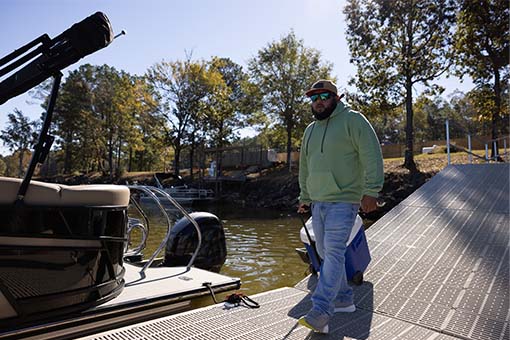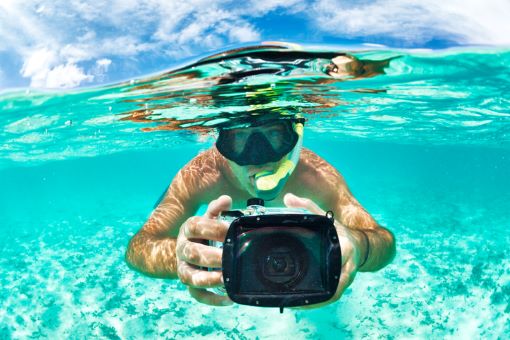When selecting the best boat cooler, your needs will vary depending on whether you enjoy activities like saltwater fishing, overnight cruising, or watersports. Once you think beyond merely keeping the items inside chilled, it takes a different cooler to fit different niches like these.
So, how will you decide which is the best cooler to bring aboard your boat? Consider the following types:
- Standard Marine Coolers
- Soft-Side Coolers
- Styrofoam Coolers
- Super Coolers
- Wheeled Coolers
Types of Boat Coolers
1. Standard Marine Coolers
Starting basic, standard marine coolers are hard-sided coolers built with hardware that can survive the marine environment. They're sturdy enough to sit on, have enough insulation to hold ice through a long day on the water, and typically cost more than your average poolside cooler.
Overall, they're an excellent option for all types of boating! (But they can be bulky and difficult to stow.) After testing dozens of models over the years, here are two top performers that stand out from the crowd:
- Coleman 316 Series
This standard marine cooler is a no-frills Coleman that does what you need – keeps ice frozen for up to 5 days in a sturdy 52-quart design. It features heavy-duty handles, leak-proof construction, and a tough plastic build that is perfect for long water days.
- RTIC Outdoors Cushion for 52 Quart Ultra Light Cooler
Another favorite cooler, the RTIC Outdoors Cushion Ultra Light Cooler, transforms your lid into comfortable boat seating with UV-resistant vinyl and a non-slip bottom. Plus, it folds for easy storage when not in use and features secure straps for stability while boating.
2. Soft-Sided Coolers
When shopping for a cooler that can be stowed in odd-shaped compartments or tight areas, soft-sided coolers are a natural choice. These flexible companions can be squished, bent, and squeezed into almost any space you need them to fit.
But they do come with some downsides. Most won't keep ice as long as rigid coolers, and you can't use them for extra seating. Plus, they rarely have drains, making cleanup more challenging than rigid models.
And here's a tip for anglers: Don't use these for your catch. Fish spines and teeth will tear up that interior lining fast. Once that happens, water seeps into the insulation, and your cooler loses its cooling power completely. But for cruising days, here are our favorites:
- L.L. Bean Softpack Adventure Cooler, 12 Liter
In terms of soft-sided coolers that won't break the bank, you can't go wrong with the L.L. Bean Softpack Adventure Cooler. It's lightweight, folds flat for easy storage, and holds 18 cans – with ice!
- CORE 20L Performance Soft Cooler Tote
This soft-sided cooler from CORE is perfect for boating trips, offering solid 2.5-day ice retention and easy transport with multiple carrying options. While not as rugged as premium marine coolers, its waterproof design and 36-can capacity make it a reliable choice for casual outings.
3. Styrofoam Coolers
These coolers are inexpensive, but they're a poor choice for use on a boat. They crack super easily, and their lightweight lids fly away in the wind. Plus, ice melts in them faster than you'd like.
But they still serve a purpose around boats. Need to move cold drinks from your house to the boat's built-in cooler? A foam cooler works fine. They also come in handy for fishermen. After a good day of angling, you can pack fresh fish in these disposable coolers and send them home with your fishing buddies.
Styrofoam coolers are available in most grocery or department stores, like this one from Ace Hardware.
4. Super Coolers
Heavy-duty super coolers have become very popular in recent years, and it's no wonder why: they can hold ice for days on end. These beasts are built tough as nails, with hardware that keeps working year after year. And most have non-slip feet that grip onto fiberglass decks like glue. Plus, many seal up tight with thick rubber gaskets to keep air and water out.
But there's a trade-off here. The price tags on these coolers will make your eyes pop.
They also weigh a ton and occupy more space than standard marine coolers. (That's because the walls are packed with extra-thick insulation.) So you get less interior space, even though the cooler looks massive from the outside.
However, they're perfect for certain boat days, and we love these premium choices:
- YETI Tundra 45 Cooler
This super cooler from YETI is built specifically for serious boating, featuring rotomolded construction and up to 54-can capacity with superior ice retention. Its non-slip feet, tie-down slots, and military-grade handles make it perfect for rough waters.
- ORCA 40 Quart Cooler
We love taking this CORE cooler for long boat trips because it's built to last – and keeps drinks cold for over a week. It's a good buy for people who like outdoor adventures because it can hold 34 cans, is heavy-duty, and has a perfect seal.
5. Wheeled Coolers
Wheeled coolers are a great option for hauling heavy loads down the dock – but they have a bunch of downsides. The wheels and extra handles require a molded-in recess in the cooler, reducing their interior capacity. And like standard marine coolers, they can be difficult to stow.
Additionally, if left unsecured on a deck, they may start rolling around when a wave hits. So, if getting from your car to your boat only requires a few steps, a wheeled cooler won't be the top pick. But if you have to hike a bit, a wheeled cooler can save you much work. To save you time and research, we've found these top-performing options:
- Igloo 60 Quart Latitude Roller Cooler
When you think of a wheeled cooler, this is most likely what comes to mind! The Igloo 60 Quart Latitude Roller Cooler makes boat days easier with its telescoping handle and rugged wheels. We like this choice because it's straightforward, affordable, and moves easily from dock to deck. And its four cup holders make it perfect for a full day of refreshments on the water.
- BrüTank 35-Quart Rolling Cooler
For a pricier option (with extra frills), meet the BrüTank 35-Quart Rolling Cooler from BrüMate! We love this one for hauling drinks and ice to the dock, and it has sturdy wheels and a built-in drink tap.
This 35-qt tank glides smoothly over any terrain and keeps ice frozen for over a week! Beyond the basics, its foam seat top and 36-can capacity make it a great addition to any outing.
Additional Cooler Considerations
While shopping, consider the pros and cons of these different cooler types to discover which fits your needs best. (Size matters most since you'll always balance cooler capacity with storage space.) In fact, many boaters keep multiple coolers – a smaller one for drinks and a larger one for fish.
Additionally, your boat's storage and seating needs might point you toward a dual-purpose cooler. Many rigid coolers come with seat cushion options; check that the cooler has good feet to prevent sliding. (Some manufacturers offer deck-mounting brackets to secure removable coolers.)
Above all, build quality should guide your cooler choice. Start by focusing on the overall strength – plus hinges, hardware, and carry handles. Naturally, plastic components often need replacement after a few seasons. Meanwhile, thick rubber latches perform better and create a stronger seal.
In marine settings, all metal parts — including screws — must be stainless steel. As for handles, molded-in types last the longest but take up space. (Alternatively, rope handles excel and offer easy replacement.)
The Best Boat Cooler: Final Thoughts
Your perfect boat cooler depends on what you need it for! Standard coolers offer reliable performance – while premium models bring extras like dividers, elevated food trays, fishing rod holders, and built-in cutting boards. (Many high-end brands offer customization through add-on accessories.)
So, explore these options and match them to your boating style. You'll quickly find that a quality cooler becomes essential to every trip out on the water!


